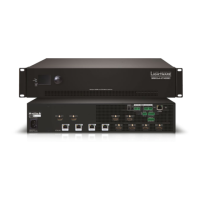MMX8x4-HT series – User's Manual 144
Event Manager Basics
These commands are detailed in the coming sections.
The following are necessary to have a successful event:
▪ Defining the Condition
▪ Defining the Action
▪ Setting the Delay (optional)
▪ Name the Event and set to Enabled
INFO: Setting the Event to Enabled as the last step is recommended.
Setting a Condition by Specifying a Direct Path
Command and Response
ç <loc><expression>
æ <loc><expression>
Parameters
The structure of the <expression> is: <node_path>.<property><value>.
Example 1
ç
æ
SignalPresent property changes to '1'.
Example 2
In some cases, the opposite is necessary: when the property does not equal with the value. If you need so,
the ConditionInverted property must be set to true:
ç
æ
ç
æ
ConnectedSource property does not equal with 'I1' (in other words: if other input
port is connected to O1 than I1).
Example 3
Sometimes, it is enough if the value of a property changes to anything. In this case, just put a ? to the end
of the property:
ç
æ
Setting a Condition by Linking Another Condition
Command and Response
ç <loc><event_nr>
æ <loc><event_nr>
Parameters
The <event_nr> means the number (location) of the linked event without letter 'E'.
Example
ç
æ
The Condition of the E2 Event is set to be the same as set at E1 Event.
Setting a Condition by Linking Conditions
DIFFERENCE:
is not enough. The practical experience has shown there is a need to examine more conditions as follows:
as follows:
Command and Response
ç <loc><event_nr><event_nr><event_nr><event_nr>
æ <loc><event_nr><event_nr><event_nr><event_nr>
Parameters
The <event_nr> parameters mean the numbers (locations) of the linked Events without letter 'E'.
Example
ç
æ
If the Condition of E1 Event exists and the Condition of E2 is detected (or vice versa), the Condition of E3 will
TIPS AND TRICKS:
Disabled.

